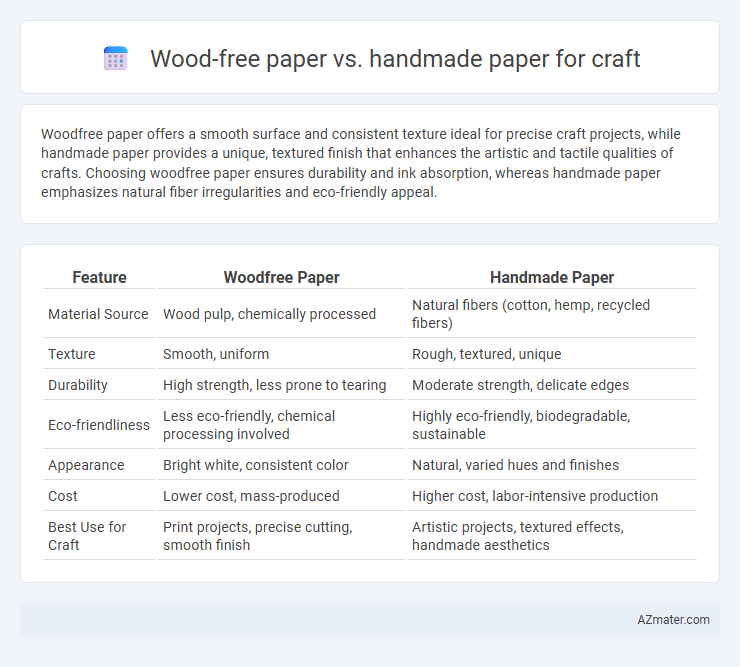Woodfree paper offers a smooth surface and consistent texture ideal for precise craft projects, while handmade paper provides a unique, textured finish that enhances the artistic and tactile qualities of crafts. Choosing woodfree paper ensures durability and ink absorption, whereas handmade paper emphasizes natural fiber irregularities and eco-friendly appeal.
Table of Comparison
| Feature | Woodfree Paper | Handmade Paper |
|---|---|---|
| Material Source | Wood pulp, chemically processed | Natural fibers (cotton, hemp, recycled fibers) |
| Texture | Smooth, uniform | Rough, textured, unique |
| Durability | High strength, less prone to tearing | Moderate strength, delicate edges |
| Eco-friendliness | Less eco-friendly, chemical processing involved | Highly eco-friendly, biodegradable, sustainable |
| Appearance | Bright white, consistent color | Natural, varied hues and finishes |
| Cost | Lower cost, mass-produced | Higher cost, labor-intensive production |
| Best Use for Craft | Print projects, precise cutting, smooth finish | Artistic projects, textured effects, handmade aesthetics |
Introduction to Woodfree and Handmade Paper
Woodfree paper is primarily made from chemical pulp, which removes lignin to produce a smooth, bright surface ideal for detailed printing and crafting. Handmade paper is crafted from natural fibers such as cotton or recycled materials, offering unique texture and durability favored in artisanal and eco-friendly projects. Both types serve distinct purposes in craft, with woodfree paper excelling in precision and handmade paper standing out for its organic aesthetic.
What is Woodfree Paper?
Woodfree paper is a high-quality paper made primarily from wood pulp that has had lignin removed to prevent yellowing and increase durability, making it ideal for detailed crafts and professional projects. It features a smooth surface suitable for precise printing and drawing, offering a consistent texture unlike the irregular surface of handmade paper. Its cost-effectiveness and availability in various weights and finishes make woodfree paper a popular choice for craft applications where uniformity and archival quality are important.
What is Handmade Paper?
Handmade paper is crafted through a manual process using natural fibers such as cotton, hemp, or recycled textiles, resulting in a unique texture and eco-friendly composition ideal for artisanal crafts. Unlike woodfree paper, which is chemically processed and mass-produced for uniformity and smoothness, handmade paper offers increased durability and a distinct, rustic appearance. This organic production method highlights its sustainability and aesthetic qualities, making it favored for high-end or personalized craft projects.
Manufacturing Process Comparison
Woodfree paper is produced using chemical pulping methods that remove lignin, resulting in a smooth, bright surface ideal for detailed printing in crafts. Handmade paper involves manual processes where natural fibers like cotton or hemp are soaked, beaten, and laid out on a screen to dry, offering a unique texture and strength preferred for artisanal craft projects. The contrast in manufacturing processes highlights woodfree paper's uniformity and mass production efficiency versus handmade paper's organic variability and eco-friendly appeal.
Texture and Appearance Differences
Woodfree paper offers a smooth, uniform texture ideal for detailed printing and precision craftwork, whereas handmade paper features a naturally uneven surface with visible fibers, adding a rustic and organic aesthetic. The bright white tone of woodfree paper contrasts with the off-white, cream, or mottled shades typical of handmade paper, enhancing the tactile and visual appeal differently. These texture and appearance distinctions influence the choice between the two for projects requiring either refined elegance or artisanal authenticity.
Printability and Surface Quality
Woodfree paper offers superior printability due to its smooth, uniform surface, enabling sharp, clear images and consistent ink absorption ideal for detailed craft prints. Handmade paper features a textured, fibrous surface that provides a unique tactile quality but may cause uneven ink distribution and less precision in printed designs. Craft projects requiring high-resolution prints benefit more from woodfree paper's reliable surface quality, while handmade paper excels in aesthetic appeal and artisanal texture.
Durability and Strength
Woodfree paper, manufactured from chemically processed wood pulp, offers high strength and durability due to its smooth surface and reduced lignin content, making it ideal for intricate craft projects requiring longevity. Handmade paper, created from natural fibers and traditional methods, provides unique texture and eco-friendliness but tends to be less durable and more prone to tearing under stress. For craft applications prioritizing strength and durability, woodfree paper outperforms handmade paper by maintaining integrity during handling and use.
Environmental Impact and Sustainability
Woodfree paper, typically made from chemical pulp removing lignin, offers higher brightness and durability but relies heavily on industrial processing that can lead to significant chemical waste and energy consumption. Handmade paper, often produced from recycled fibers or natural materials without harmful chemicals, supports sustainable practices by reducing resource depletion and minimizing pollution. Choosing handmade paper for crafts promotes eco-friendly sustainability by encouraging artisanal methods and reducing environmental impact compared to conventional woodfree paper.
Cost and Availability
Woodfree paper is generally more cost-effective and widely available due to mass production and industrial processes, making it suitable for large-scale craft projects requiring uniformity. Handmade paper, produced in limited quantities with traditional methods, tends to be more expensive and harder to source, offering unique texture and aesthetic appeal valued in artisanal crafts. Choosing between woodfree and handmade paper depends on budget constraints and desired material characteristics for specific craft applications.
Best Uses for Crafts: Woodfree vs Handmade Paper
Woodfree paper offers a smooth, consistent surface ideal for detailed printing, painting, and precision cutting in craft projects such as scrapbooking and card making. Handmade paper provides a unique texture and natural fiber inclusions perfect for rustic, artistic creations like invitations, bookbinding, and mixed media art. Choosing between woodfree and handmade paper depends on the desired aesthetic and technique, with woodfree suited for precision and durability, while handmade excels in organic, tactile craft applications.

Infographic: Woodfree paper vs Handmade paper for Craft
 azmater.com
azmater.com